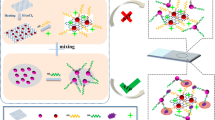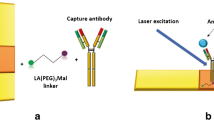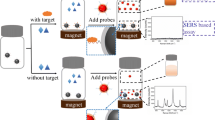Abstract
A ratiometric nanoensemble-functionalized Surface-Enhanced Raman Spectroscopy (SERS) chip is proposed and an ultrasensitive “sandwich” structure introduced for the detection of 5-HT to achieve early diagnosis of colon cancer. The SERS-based chip contains core–shell SERS active substrates coded by different Raman tags with Raman-silent region peaks (Au@EBP@Au NR arrays and Au@MBN@Ag NPs) and then identify-function molecule modification to construct the “sandwich” structure (Au@EBP@Au NR arrays/5-HT/Au@MBN@Ag NPs). Au@EBP@Au NR arrays showed excellent SERS performance, including good uniformity with an RSD of 5.53% and an enhancement factor (EF) of 2.13 × 107. The intensity ratio of the peaks in the Raman silent region was proportional to the concentration of 5-HT in the range 5 × 10−7–1 × 10−3 M, with a detection limit (LOD) of 4.9 × 10−9 M. Excellent assay accuracy was also demonstrated, with recoveries in the range 96.80% to 104.96%. Finally, we found that 5-HT expression levels in normal human sera were much lower than those in colon cancer patients by using a SERS-based chip for determination of the concentration of 5-HT in clinical colon cancer serum. This result suggested that the proposed approach has potential for detecting 5-HT by ratiometric SERS-based chips for early diagnosis of colon cancer.
Graphical Abstract






Similar content being viewed by others
Data Availability
The processed data required to reproduce these findings cannot be shared at this time as the data also forms part of an ongoing study.
References
Yano Jessica M, Yu K, Donaldson Gregory P, Shastri Gauri G, Ann P, Ma L, Nagler Cathryn R, Ismagilov Rustem F, Mazmanian Sarkis K, Hsiao Elaine Y (2015) Indigenous bacteria from the gut microbiota regulate host serotonin biosynthesis. Cell 161(2):264–276
Spencer NJ (2015) Constitutively active 5-HT receptors: an explanation of how 5-HT antagonists inhibit gut motility in species where 5-HT is not an enteric neurotransmitter? Front Cell Neurosci 9:487
Martin AM, Yabut JM, Choo JM, Page AJ, Sun EW, Jessup CF, Wesselingh SL, Khan WI, Rogers GB, Steinberg GR, Keating DJ (2019) The gut microbiome regulates host glucose homeostasis via peripheral serotonin. P Natl A Sci 116(40):19802
Khoshnevisan K, Maleki H, Honarvarfard E, Baharifar H, Gholami M, Faridbod F, Larijani B, Faridi Majidi R, Khorramizadeh MR (2019) Nanomaterial based electrochemical sensing of the biomarker serotonin: a comprehensive review. Mikrochim Acta 186:49
Ye D, Xu H, Tang Q, Xia H, Zhang C (1876) Bi F (2021) The role of 5-HT metabolism in cancer. BBA - Rev Cancer 1876(2):188618
Warner ME, Naranjo J, Pollard EM, Weingarten TN, Warner MA, Sprung J (2017) Serotonergic medications, herbal supplements, and perioperative serotonin syndrome. Can J Anaesth 64(9):940–946
Heise CW, Malashock H, Brooks DE (2017) A review of vilazodone exposures with focus on serotonin syndrome effects. Clin Toxicol (Phila) 55(9):1004–1007
Nikolaus S, Schulte B, Al-Massad N, Thieme F, Schulte DM, Bethge J, Rehman A, Tran F, Aden K, Hasler R, Moll N, Schutze G, Schwarz MJ, Waetzig GH (2017) Increased tryptophan metabolism is associated with activity of inflammatory bowel diseases. Gastroenterology 153(6):1504-1516 e2
Belmer A, Maroteaux L (2019) Regulation of raphe serotonin neurons by serotonin 1A and 2B receptors. Neuropsychopharmacology 44(1):218–219
Xie Y, Wang C, Zhao D, Wang C, Li C (2020) Dietary proteins regulate serotonin biosynthesis and catabolism by specific gut microbes. J Agr Food Chem 68(21):5880–5890
Kannen V, Bader M, Sakita JY, Uyemura SA, Squire JA (2020) The dual role of serotonin in colorectal cancer. Trends Endocrinol Metab 31(8):611–625
Hashimoto T, Perlot T, Rehman A, Trichereau J, Ishiguro H, Paolino M, Sigl V, Hanada T, Hanada R, Lipinski S, Wild B, Camargo SM, Singer D, Richter A, Kuba K, Fukamizu A, Schreiber S, Clevers H, Verrey F, Rosenstiel P, Penninger JM (2012) ACE2 links amino acid malnutrition to microbial ecology and intestinal inflammation. Nature 487(7408):477–481
Shajib MS, Baranov A, Khan WI (2017) Diverse effects of gut-derived serotonin in intestinal inflammation. ACS Chem Neurosci 8(5):920–931
De Vadder F, Grasset E, Mannerås Holm L, Karsenty G, Macpherson AJ, Olofsson LE, Bäckhed F (2018) Gut microbiota regulates maturation of the adult enteric nervous system via enteric serotonin networks. P Natl A Sci 115(25):6458
Wu H, Herr D, MacIver NJ, Rathmell JC, Gerriets VA (2020) CD4 T cells differentially express cellular machinery for serotonin signaling, synthesis, and metabolism. Int Immunopharmacol 88:106922
Tutton PJM, Barkla DH (1978) The Influefnce of serotonin on the mitotic rate in the colonic cypt epithelium and in colonic adenocarcinoma in rats. Clin Exp Pharmacol P 5(1):91–94
Nocito A, Dahm F, Jochum W, Jang JH, Georgiev P, Bader M, Graf R, Clavien PA (2008) Serotonin regulates macrophage-mediated angiogenesis in a mouse model of colon cancer allografts. Cancer Res 68(13):5152–5158
Mikael L, Niina T, Risto R, Esa H, Camilla S, Outi I (2018) Comparison of serum serotonin and serum 5-HIAA LC-MS/MS assays in the diagnosis of serotonin producing neuroendocrine neoplasms: A pilot study. Clin Chim Acta 482:78–83
Xu QQ, Luo L, Liu ZG, Guo Z, Huang XJ (2022) Highly sensitive and selective serotonin (5-HT) electrochemical sensor based on ultrafine Fe(3)O(4) nanoparticles anchored on carbon spheres. Biosens Bioelectron 222:114990
Hernández-Mendoza GA, Aguirre-Olivas D, González-Gutiérrez M, Leal HJ, Qureshi N, Treviño-Palacios CG, Peón J, De-Miguel FF (2020) Fluorescence of serotonin in the visible spectrum upon multiphotonic photoconversion. Biomed Opt Express 11(3):1432–1448
Khoshnevisan K, Honarvarfard E, Torabi F, Maleki H, Baharifar H, Faridbod F, Larijani B, Khorramizadeh MR (2020) Electrochemical detection of serotonin: a new approach. Clin Chim Acta 501:112–119
Wang Z, Zhang Y, Zhang B, Lu X (2018) Mn(2+) doped ZnS QDs modified fluorescence sensor based on molecularly imprinted polymer/sol-gel chemistry for detection of Serotonin. Talanta 190:1–8
Do PQT, Huong VT, Phuong NTT, Nguyen T-H, Ta HKT, Ju H, Phan TB, Phung V-D, Trinh KTL, Tran NHT (2020) The highly sensitive determination of serotonin by using gold nanoparticles (Au NPs) with a localized surface plasmon resonance (LSPR) absorption wavelength in the visible region. RSC Adv 10:30858–30869
Xia D, Jiang P, Cai Z, Zhou R, Tu B, Gao N, Chang G, He H, He Y (2022) Ag nanocubes monolayer-modified PDMS as flexible SERS substrates for pesticides sensing. Mikrochim Acta 189:232
Song P, Guo X, Pan Y, Wen Y, Zhang Z, Yang H (2013) SERS and in situ SERS spectroelectrochemical investigations of serotonin monolayers at a silver electrode. Electroanal Chem 688:384–391
Zhou T, Fan M, You RY, Lu YD, Huang LQ, Xu YC, Feng SY, Wu Y, Shen HY, Zhu LJ (2020) Fabrication of Fe3O4/Au@ATP@Ag Nanorod sandwich structure for sensitive SERS quantitative detection of histamine. Anal Chim Acta 1104:199–206
Wei W, Wang Y, Ji J, Zuo S, Li W, Bai F, Fan H (2018) Fabrication of large-area arrays of vertically aligned gold nanorods. Nano Lett 18(7):4467–4472
Hanske C, Hill EH, Vila-Liarte D, Gonzalez-Rubio G, Matricardi C, Mihi A, Liz-Marzan LM (2019) Solvent-assisted self-assembly of gold nanorods into hierarchically organized plasmonic mesostructures. ACS Appl Mater Interfaces 11(12):11763–11771
Godoy-Reyes TM, Llopis-Lorente A, Costero AM, Sancenón F, Gaviña P, Martínez-Máñez R (2018) Selective and sensitive colorimetric detection of the neurotransmitter serotonin based on the aggregation of bifunctionalised gold nanoparticles. Sensor Actuat B-Chem 258:829–835
Sha Q, Sun B, Yi C, Guan R, Fei J, Hu Z, Liu B, Liu X (2019) A fluorescence turn-on biosensor based on transferrin encapsulated gold nanoclusters for 5-hydroxytryptamine detection. Sens Actuators, B Chem 294:177–184
Kuldeep M, Buddhadev P, Keshav B, Amit J, Pranjal C (2019) Novel electrochemical biosensor for serotonin detection based on gold nanorattles decorated reduced graphene oxide in biological fluids and in vitro model. Biosens Bioelectron 142:111502
Zhao Y-Y, Li H, Ge Q-M, Cong H, Liu M, Tao Z, Zhao J-L (2020) A chemo-sensor constructed by nanohybrid of multifarene[3,3] and rGO for serotonin hydrochloride with dual response in both fluorescence and voltammetry. Microchem J 158:105145
Araghi M, Soerjomataram I, Jenkins M, Brierley J, Morris E, Bray F, Arnold M (2019) Global trends in colorectal cancer mortality: projections to the year 2035. Int J Cancer 144(12):2992–3000
Sato K, Ito S, Kitagawa T, Hirahata K, Hihara D, Tominaga K, Yasuda I, Maetani I (2017) A prospective randomized study of the use of an ultrathin colonoscope versus a pediatric colonoscope in sedation-optional colonoscopy. Surg Endosc 31(12):5150–5158
Slattery ML, Edwards SL, Ma KN, Friedman GD (2000) Colon cancer screening, lifestyle, and risk of colon cancer. Cancer Cause Control 11(6):555–563
Gao Y, Wang J, Zhou Y, Sheng S, Qian SY, Huo X (2018) Evaluation of serum CEA, CA19-9, CA72-4, CA125 and ferritin as diagnostic markers and factors of clinical parameters for colorectal cancer. Sci Rep 8(1):2732
Gangireddy VGR, Coleman T, Kanneganti P, Talla S, Annapureddy AR, Amin R, Parikh S (2018) Polypectomy versus surgery in early colon cancer: size and location of colon cancer affect long-term survival. Int J Colorectal Dis 33(10):1349–1357
Chávez JL, Hagen JA, Kelley-Loughnane N (2017) Fast and selective plasmonic serotonin detection with aptamer-gold nanoparticle conjugates. Sensors 17(4):681
Mao L, Xin F, Ren J, Xu S, Huang H, Zha X, Wen X, Gu G, Yang G, Cheng Y, Zhang C, Wang W, Liu X (2022) 5-HT2B-mediated serotonin activation in enterocytes suppresses colitis-associated cancer initiation and promotes cancer progression. Theranostics 12(8):3928–3945
Li T, Fu B, Zhang X, Zhou Y, Yang M, Cao M, Chen Y, Tan Y, Hu R (2021) Overproduction of gastrointestinal 5-HT promotes colitis-associated colorectal cancer progression via enhancing NLRP3 inflammasome activation. Cancer Immunol Res 9(9):1008–1023
Funding
We are grateful for the support by the Fujian Provincial Department of Science and Technology guiding Project (2020Y0019), the Youth and Middle-Aged Backbone Talents Training Project of Fujian Health Commission (2020GGA003), the National Natural Science Foundation of China (No. 61975031), the Program for Industry University Cooperation Project of Fujian Province (2020Y4006), the Innovative Research Team in Science and Technology in Fujian Province University, the Achievement Transformation Project of Fuzhou Science and Technology Bureau (2020-GX-20), and the Fushimei Agricultural and Rural Maker Space (Minke xing〔2019〕No. 2).
Author information
Authors and Affiliations
Contributions
Min Fan: investigation, writing—original draft. Sirui Han: investigation, methodology, writing—review and editing. Ruiyun You: resources, writing—review and editing. Jingbo Chen: investigation, formal analysis. Shangyuan Feng: formal analysis. Yudong Lu: supervision, funding acquisition, resources.
Corresponding authors
Ethics declarations
Competing interests
The authors declare no competing interests.
Additional information
Publisher's note
Springer Nature remains neutral with regard to jurisdictional claims in published maps and institutional affiliations.
Supplementary Information
Below is the link to the electronic supplementary material.
Rights and permissions
Springer Nature or its licensor (e.g. a society or other partner) holds exclusive rights to this article under a publishing agreement with the author(s) or other rightsholder(s); author self-archiving of the accepted manuscript version of this article is solely governed by the terms of such publishing agreement and applicable law.
About this article
Cite this article
Fan, M., Han, S., Huang, Q. et al. Ratiometric SERS-based assay with “sandwich” structure for detection of serotonin. Microchim Acta 190, 100 (2023). https://doi.org/10.1007/s00604-023-05634-0
Received:
Accepted:
Published:
DOI: https://doi.org/10.1007/s00604-023-05634-0




